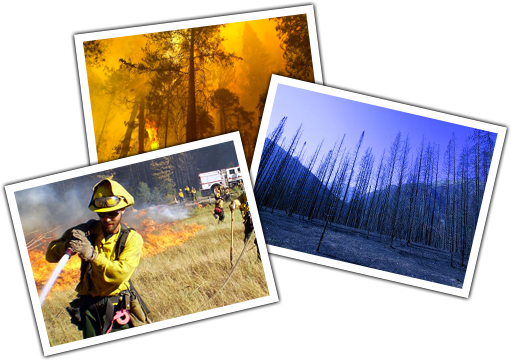Wildland Fire Still an Unsolved Problem
SOURCE: RAMONA SENTINEL
Michael Scott-Blair’s two articles in the July 9th Sentinel on retired Chief Steve Butler’s efforts to raise fire awareness and on his fire equipment company raise a number of important issues that people living in the San Diego backcountry should think long and hard about.
Many points that Chief Butler raises in these articles—the importance of planning and preparedness, the importance of defensible space, the fact that defended homes are much more likely to survive, and the fact that embers ignite most homes—are well-supported by scientific data and by most members of the fire community. However, not all suggestions and statements he makes represent the consensus of either the fire community or fire science.
The approach that Chief Butler favors is very similar to the “Stay and Defend or Leave Early” strategy practiced throughout much of Australia. In this model, able-bodied adults are encouraged to stay and defend their property, applying a tactic of “Outside-Inside-Outside,” or sheltering in the home as the fire front passes. Over the years, this strategy racked up some impressive successes, and had (and still has) a number of admirers in our own fire services and among fire scientists. That admiration was shaken on Feb. 7, 2009—Black Saturday—when fires ripped through the Gippsland region of Victoria, Australia, killing 170 people. As testimony before the Victorian Royal Bushfire Commission has shown—contrary to an assertion made by Chief Butler—roughly half of the fatalities were found in their homes, and not fleeing on the road.
Exactly what went wrong is under investigation, but an indication is given by a harrowing first-person article written by a columnist for The Australian, who, with his family, lost his home and barely survived. While well-prepared and equipped (including a pool-pump and fire hose), the intensity of the ember attack was such that it found hidden vulnerabilities in his home, which was engulfed in flames before it was safe to go outside. In other communities, fire spread from home to home. It may be found that not all homes people think are defendable actually are, and that not all adults who think that they are capable of defending them actually can.
There are a number of approaches to reducing home vulnerabilities. I’ve been recently privileged to participate in a task force on ignition-resistant building standards run by the California State Fire Marshal’s office. Proposed changes, in addition to other recent additions to fire code, should significantly reduce the probability of ember ignition in new construction. Existing structures can benefit from gels (as mentioned by Chief Butler) or from water spray systems, such as the one I developed for my own home (and have published articles on) that saved it during the Cedar fire. But do we stay in these safer homes or go?
Contrary to the approach suggested by Chief Butler, the official position of county fire agencies is early evacuation. Using Reverse 9-1-1, this was put into effect in 2007, resulting in the evacuation of Ramona and many other areas. It is rightly touted as a success, with casualties lower in 2007 than they were in 2003. Just because something works once, though, doesn’t mean it always will. Ramonans remember the long lines of traffic at a standstill, making them vulnerable to a rapidly running fire or new ignitions (as reported by the UT, some Witch fire evacuees on Route 78 had to be turned back when the Guejito fire started in San Pasqual Valley). This should serve as a warning that we might not be so lucky next time.
Another approach taken by the County of San Diego is to allow “Shelter-in-Place” communities in areas earlier understood to be too hazardous to build in, thus opening up new areas of the county for development. Because these use the most advanced construction techniques, officials assume that these homes will not burn in wildfires, and that people can shelter safely inside them. Unlike the approach Butler discusses, this is a passive defense, and training and equipment are not considered necessary. However, should the unexpected occur and any of these homes ignite, the untrained and unequipped people inside would be at grave risk.
Here’s the problem: All of the brilliant ideas of fire professionals and scientists are only rarely put to the test, because extreme fires are rare, and unexpected things happen under extreme conditions. Corrections, when they come, can be tragic and brutal, as they were recently in Australia. Professionals and scientists need to be humble and cautious in their assertions, because they’re experimenting on live subjects. None of these approaches has been proven to be a complete solution to the wildland fire problem.
What I think everybody would agree on is that many of us in the backcountry are living in a giant pool of gasoline, that fires are inevitable, that homes will be lost, and people will die. Likewise, there would be consensus that well-trained, prepared and equipped residents living in homes with defensible space and that are difficult to ignite, and who are given up-to-date and accurate fire and traffic information will be able to choose to stay or go in a way that minimizes the risk to their families and property. In San Diego County we are far from this ideal, and we need to be careful not to accept half measures as full answers. You—as a resident of the backcountry—have control over how much you know and how you prepare yourself and your home. The more effort you put into this, the more and better options you will have when fire returns, whether you stay or go.
Joseph Mitchell is a 10-year Ramona resident and physicist who has developed a water spray wildland fire defense system that he has placed into the public domain at his website: www.mbartek.com.
Link to original Article: http://www.ramonasentinel.com/2009/07/23/wildland-fire-still-an-unsolved-problem/

